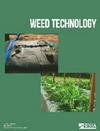用乙酰草胺除草剂混合物控制玉米中的多种抗除草剂水麻(Amaranthus tuberculatus)。
IF 1.7
3区 农林科学
Q3 AGRONOMY
引用次数: 0
摘要
水麻是一种夏季一年生阔叶杂草,繁殖力强,种子在土壤中寿命短,遗传多样性广。其种群已进化出对五种除草剂作用模式(第 2、5、9、14 和 27 组)的抗性,这些抗性遍布安大略省南部;这增加了在玉米田控制这种竞争性杂草物种的挑战,而玉米是世界上最重要的粮食作物,也是安大略省价值最高的农作物。乙草胺是一种第 15 组土壤施用的残留除草剂,对许多禾本科和阔叶杂草具有活性,但尚未在加拿大注册。本研究的目的是确定乙草胺与氟磺胺草醚、麦草畏、阿特拉津、异噁唑草酮/二氟苯草醚或介草酮+阿特拉津的混剂在玉米出苗前施用是否能提高对耐多种除草剂(MHR)水麻的控制效果。2022 年至 2023 年期间进行了五次田间试验。没有观察到玉米受到伤害。单独施用乙草胺可在施药后12周(WAA)控制MHR水麻97%。所有除草剂混合物对 MHR waterhemp 的控制效果相似,12 WAA 后≥98%;除草剂混合物之间没有差异。氟磺胺草醚、麦草畏和阿特拉津对 MHR 水麻的控制效果低于所有其他除草剂处理,而且不会降低密度或生物量。乙草胺可将水麻密度降低 98%,而乙草胺混合物同样可将密度降低 99% 至 100%。这项研究的结论是,所评估的乙草胺混合物对水麻有很好的控制效果,但控制效果并不比单独使用乙草胺强。除草剂除草剂混合物应作为一种最佳管理方法来使用,以减少除草剂抗药性的演变。本文章由计算机程序翻译,如有差异,请以英文原文为准。
Control of multiple herbicide-resistant waterhemp (Amaranthus tuberculatus) with acetochlor-based herbicide mixtures in corn
Waterhemp is a summer annual, broadleaf weed with high fecundity, short seed longevity in the soil, and wide genetic diversity. Populations have evolved resistance to five herbicide modes of action (Groups 2, 5, 9, 14, and 27), which are present across southern Ontario; this has increased the challenge of controlling this competitive weed species in corn, the most important grain crop produced worldwide, and the highest value agronomic crop in Ontario. Acetochlor is a Group 15 soil-applied residual herbicide that has activity on many grass and broadleaf weeds but has yet to be registered in Canada. The objective of this study was to ascertain whether mixtures of acetochlor with flumetsulam, dicamba, atrazine, isoxaflutole/diflufenican, or mesotrione + atrazine applied preemergence would increase the control of multiple herbicide-resistant (MHR) waterhemp in corn. Five field trials were conducted between 2022 and 2023. No corn injury was observed. Acetochlor applied alone controlled MHR waterhemp 97% 12 weeks after application (WAA). All herbicide mixtures controlled MHR waterhemp similarly at ≥98% 12 WAA; there were no differences among herbicide mixtures. Flumetsulam, dicamba, and atrazine provided lower MHR waterhemp control than all other herbicide treatments and did not reduce density or biomass. Acetochlor reduced waterhemp density 98%, while the acetochlor mixtures reduced density similarly at 99 to 100%. This study concludes that the acetochlor mixtures evaluated provide excellent waterhemp control; however, control was not greater than acetochlor alone. Herbicides herbicide mixtures should be used as a best management practice to mitigate the evolution of herbicide resistance.
求助全文
通过发布文献求助,成功后即可免费获取论文全文。
去求助
来源期刊

Weed Technology
农林科学-农艺学
CiteScore
2.90
自引率
21.40%
发文量
89
审稿时长
12-24 weeks
期刊介绍:
Weed Technology publishes original research and scholarship in the form of peer-reviewed articles focused on understanding how weeds are managed.
The journal focuses on:
- Applied aspects concerning the management of weeds in agricultural systems
- Herbicides used to manage undesired vegetation, weed biology and control
- Weed/crop management systems
- Reports of new weed problems
-New technologies for weed management and special articles emphasizing technology transfer to improve weed control
-Articles dealing with plant growth regulators and management of undesired plant growth may also be accepted, provided there is clear relevance to weed science technology, e.g., turfgrass or woody plant management along rights-of-way, vegetation management in forest, aquatic, or other non-crop situations.
-Surveys, education, and extension topics related to weeds will also be considered
 求助内容:
求助内容: 应助结果提醒方式:
应助结果提醒方式:


